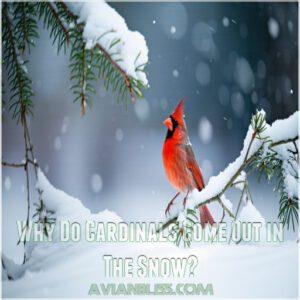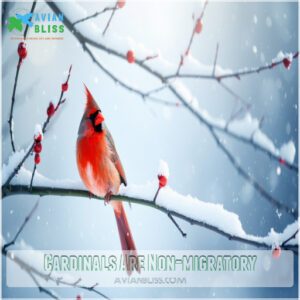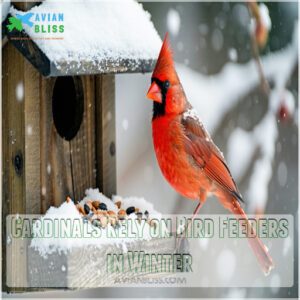This site is supported by our readers. We may earn a commission, at no cost to you, if you purchase through links.

Unlike migratory birds, they stick around year-round, using their striking red plumage to defend territories and charm mates against a white landscape.
Their feathers provide insulation, while flocking helps conserve warmth and boosts food-finding success.
In winter, they shift to seeds and berries, often gathering around feeders for sunflower seeds—their favorite snack.
You’ll notice males eat first, sharing with females and young after.
Cardinals also sing during winter, their melodies weaving beauty into cold, quiet days.
Their resilience makes them a true symbol of hope amidst winter’s chill.
Table Of Contents
- Key Takeaways
- Why Do Cardinals Come Out in The Snow?
- Cardinals Are Conspicuous Against Snow
- Cardinals Are Non-migratory
- Cardinals Forage in Flocks in Winter
- Cardinals Rely on Bird Feeders in Winter
- Cardinals Sing to Defend Territories
- Cardinals Symbolize Hope and Beauty in Winter
- Frequently Asked Questions (FAQs)
- Why do cardinals come out in the snow?
- How do Cardinals survive snow?
- Why do Cardinals eat snow?
- Why do northern cardinals look lighter in winter?
- What do Cardinals do in winter?
- Why do Cardinals not fly south for the winter?
- What does a cardinal in the snow mean?
- Do cardinals come out in the snow?
- Why do I only see cardinals when it snows?
- What is the old saying about seeing a cardinal?
- Conclusion
Key Takeaways
- You’ll spot cardinals in the snow because they don’t migrate, relying on seeds, berries, and teamwork in flocks to survive the cold.
- Their bright red feathers stand out in snowy landscapes, helping them attract mates and defend territories with striking visibility.
- Cardinals insulate themselves by fluffing their feathers and roosting in dense shrubs or evergreens to stay warm.
- Males often sing to establish territory, while females use their intricate vocalizations to communicate and coordinate survival strategies.
Why Do Cardinals Come Out in The Snow?
When the snow blankets the ground, cardinals seem to come alive, dotting the white landscape with flashes of red.
But why do they come out during snow? These non-migratory birds rely on their snowy habitat to find food and survive winter’s chill.
Their winter feeding habits are essential—they forage for seeds, berries, and even insects under the snow.
Cardinals also show fascinating snow behavior, like fluffing their feathers for insulation. Think of it as putting on a cozy jacket to trap warm air.
Their cold adaptation strategies let them thrive where others might struggle. Understanding cardinal winter survival is key to appreciating how these birds cope with harsh weather conditions.
Watching a cardinal bird in the snow, you’ll notice their resourcefulness—they may even eat snow to hydrate! In winter, it’s all about survival and cleverness.
Cardinals Are Conspicuous Against Snow
You can’t miss a cardinal against a snowy background—the male’s bright red feathers practically glow.
This striking color isn’t just for show; it helps them attract mates and defend their territories, even in the depths of winter, with the bright red feathers being a key factor.
Bright Red Plumage Stands Out in Winter Landscapes
A male red cardinal in the snow feels like nature’s highlight reel.
That red plumage practically glows, offering an unbeatable contrast against a snowy landscape.
While the striking color helps males stay visible and defend their turf, females rely on their subtle winter camouflage.
Together, these colorful feather patterns make cardinals in snow a perfect blend of survival and beauty.
The vibrant red coloration of cardinals is a result of carotenoid metabolism processes that transform dietary carotenoids into bold red pigments.
Helps Attract Mates and Defend Territories
That striking red isn’t just for looks—it’s a bold statement.
Cardinals in snow use their vibrant feathers for mate attraction, signaling strength and health during bird courtship.
It’s like wearing a neon sign that says, "Pick me!" Plus, their territorial behavior thrives on visibility, helping them guard their winter habitat.
Feather signaling is central to their winter strategies for survival.
Females Also Have Distinctive Gray/brown Coloring
While males flaunt bright red plumage, female northern cardinals bring their own charm with gray plumage and brown feathers, blending into the winter landscape like nature’s quiet guardians.
This winter camouflage protects nests and helps during foraging.
Females communicate actively with song, often for:
- Defending territories
- Attracting mates
- Warning competitors
- Coordinating with males
Perfect for winter bird watching!
Cardinals Are Non-migratory
You’ve probably noticed cardinals sticking around your yard, even when other birds fly south for the winter.
That’s because they’re non-migratory and have impressive strategies to survive the cold without needing to travel.
Remain in Their Territories Year-round
While many birds migrate, Northern Cardinals stick close to home all year round.
These nonmigratory birds rely on winter adaptations like feather insulation and cold survival tactics to thrive.
Their winter diet shifts to berries and seeds, and they often rely on backyard feeders for sustenance.
Their territorial behavior keeps their space secure, even in harsh conditions.
You’ll often spot them roosting in dense evergreens near favorite feeding spots, showcasing resilience and loyalty to their range.
| Trait | Description | Example |
|---|---|---|
| Residency | Year-round | Never migrates |
| Winter Strategy | Cold survival adaptations | Feathers, snow roosting |
| Behavior | Territorial | Defends home range in winter |
Short Wings Not Suited for Long Migrations
Cardinals stay year-round because their wing structure limits long-distance flights.
These nonmigratory birds rely on shorter, precise flight patterns suited to local movements.
Their feather adaptation strengthens resilience in the cold, making cardinals’ snow behavior remarkable.
Instead of migrating, they embrace winter roosting and thrive where others flee.
Watching a vibrant cardinal bird in the snow reminds you of their persistence against nature’s challenges.
To support these birds, providing non migratory birds feeders can be an effective way to guarantee their well-being during harsh winter conditions.
Adapt to Winter Conditions Through Various Strategies
Cardinals handle cold weather with brilliant strategies, such as winter roosting in flocks which helps them share warmth, while feather insulation traps heat.
They shift their diet, relying on food storage like seeds and berries to sustain energy, and maintaining consistent feeding schedules, as detailed in this winter cardinal feeding guide, is essential for their survival.
Cardinals adjust their body temperature slightly to conserve energy, and their loyalty to a familiar winter bird survival habitat keeps them thriving, even when snow blankets the ground.
Cardinals Forage in Flocks in Winter
You’ll often see cardinals flocking together in winter, not just for company but for survival.
By foraging in groups, they protect each other and boost their odds of finding scarce food, even if the males like to grab the first bite, which is related to their flocking behavior.
Form Mixed Flocks With Other Birds for Protection
Winter bird survival often means teamwork, and cardinals embrace this by joining mixed-species flocks.
These groups, featuring juncos and sparrows, provide bird safety through shared vigilance against predators.
Cardinals’ snow behavior benefits too—they stay warmer through shared winter roosting and use flock behavior to strengthen social bonding.
It’s nature’s version of a neighborhood watch and cozy winter gathering rolled into one.
Providing the right winter bird food sources is essential for their survival during harsh winter months.
Increase Chances of Finding Food Sources
When flocks forage together, everyone benefits.
Cardinals in snow share food locations, boosting survival during harsh weather.
You’ll notice how they scout for seeds, berries, and nutrient sources more effectively as a group.
Here’s why flocks work:
- Shared knowledge of food availability.
- Improved winter foraging efficiency.
- Safer bird feeding in snow.
- Better berry selection through teamwork.
Cardinals often rely on Bird Seed Feeders to find essential nutrients during winter, and this is an example of how teamwork and shared knowledge enhance their survival.
Males Often Eat First, Then Feed Females and Young
In winter foraging, males often eat first, showcasing their key role in feeder dynamics.
This isn’t selfish—it’s strategy.
Males husk seeds and pass them “beak to beak” to females, showcasing tender Cardinal Courtship and ensuring survival.
Female "fluttering signals" encourage feeding.
Below, observe key behaviors:
| Behavior | Purpose | Fun Fact |
|---|---|---|
| Males eat first | Gain energy | They protect flocks |
| Beak-to-beak feeding | Bond strengthening | Called "seed kisses" |
| Female fluttering wings | Request food | Enhances pair bond |
| Males husk seeds | Easier for females | Shows devotion |
Cardinals Rely on Bird Feeders in Winter
You’ll often spot cardinals at bird feeders in winter, relying on them for easy access to seeds when natural food is scarce.
They especially love sunflower seeds, which provide the high calories they need to stay warm.
Supplement Their Diet of Seeds and Berries
Snow-covered landscapes push cardinals to get creative with their meals.
They’ve got a knack for winter foraging, prioritizing seeds and berries that meet their nutrient needs.
You’ll often spot them rummaging for:
- Seed storage: Leftover seeds buried in leaf litter.
- Berry selection: Fruits clinging to shrubs and trees.
- Food variety: A mix of nuts, grains, and dried fruit.
Their resilience is impressive!
Prefer Sunflower Seeds at Feeders
Did you know sunflower seeds are the cardinal’s equivalent of a winter superfood?
Packed with energy, they’re perfect for fueling these birds’ snow adventures.
Males often eat first at feeders, keeping an eye on their flock.
By offering sunflower seeds in different feeder types, you’re not just supporting bird nutrition, but also catching an up-close view of cardinals’ snow behavior and winter foraging.
Understanding the benefits of sunflower seed nutrition is essential for attracting cardinals to your outdoor feeders.
Cardinals Sing to Defend Territories
You’ll often hear cardinals singing in winter as they establish and defend their territories.
Male and female cardinals use their songs to communicate, and their voices carry beautifully through the still, snowy landscapes.
Males Sing to Attract Mates and Establish Boundaries
Even in the stillness of snowy landscapes, male Northern Cardinals use their songs to stand out.
Their singing behavior isn’t just for show—it’s bird communication at its finest.
These melodies stake their claim on territory while doubling as irresistibly loud love notes for mate attraction.
This vocal performance is a key piece of cardinal bird facts and their bold snow behavior.
Females Also Sing, Often More Elaborately
Female cardinals bring flair to bird vocalizations with their intricate winter serenades.
Singing often more elaborately than males, they belt out tunes to assert territory and communicate during nesting.
Their melodies feature incredible range and complexity.
Here’s why it matters:
- Female Song Patterns: Tactical and quiet.
- Cardinal Courtship: A duet of love and teamwork.
- Avian Music: Nature’s delicate harmony!
Singing is More Noticeable Against The Quiet Winter Backdrop
In winter’s stillness, cardinal songs stand out like frosty chirps against a quiet backdrop.
Their cold weather melodies amplify, cutting through the snowy hush.
Males often belt icy trills to claim space, a key snow bird activity.
Females add intricate snowy serenades too.
This winter bird activity, tied to cardinals’ snow behavior, highlights their resilience and charm during snow-filled days.
Cardinals Symbolize Hope and Beauty in Winter
A burst of color in winter’s gray stillness, northern cardinals are symbols of hope and resilience.
Their vibrant red plumage lights up snowy landscapes, making them impossible to miss.
Males flaunt this bold hue, while females bring a softer beauty with their gray-brown tones and reddish highlights—proof that nature defies rigid beauty standards.
You’ll often spot them in flocks, showcasing fascinating winter bird behavior like foraging together and guarding food sources.
Their cheerful song and bold presence during the coldest months inspire renewal and cheer, despite the challenges of harsh weather.
Cardinals in cold weather remind us to embrace life’s contrasts, symbolizing renewal and cheer in the midst of harsh weather.
Frequently Asked Questions (FAQs)
Why do cardinals come out in the snow?
Cardinals stand out in the snow because their bright red feathers make them easy to spot.
They come out searching for food, defend their territory, and show off survival smarts by thriving even in harsh winters.
How do Cardinals survive snow?
They tough it out by fluffing feathers for warmth, sharing heat in groups, and snacking on high-fat foods like seeds.
Cardinals seek shelter in shrubs, conserve energy, and even shiver to stay cozy during snowy days.
Why do Cardinals eat snow?
Imagine snow as nature’s water cooler.
Cardinals eat snow to hydrate when liquid water’s scarce, it’s their clever way of staying refreshed, maintaining energy, and surviving winter without relying on frozen ponds or streams, by using snow as a source of hydration and staying refreshed.
Why do northern cardinals look lighter in winter?
You’ll notice northern cardinals looking lighter in winter because their feathers wear down, exposing paler bases underneath.
It’s like their vibrant red fades a little, but don’t worry—they’ll molting and refresh their look come spring!
What do Cardinals do in winter?
When the going gets tough, the tough get going.
Cardinals stay active in winter, fluffing feathers for warmth, roosting together, and enjoying seeds and berries.
They’re survivors, thriving in snow with smart food searches and teamwork.
Why do Cardinals not fly south for the winter?
Cardinals don’t fly south because they’ve mastered winter survival.
They rely on fluffy feathers, fat reserves, and teamwork to endure the cold.
Staying put also means defending territories and accessing food without competing in new areas.
What does a cardinal in the snow mean?
A cardinal in the snow often symbolizes perseverance and warmth in harsh conditions.
Their vivid red feathers stand out against white snow, reminding you of resilience during winter’s challenges and the beauty in enduring tough times.
Do cardinals come out in the snow?
You’ll often spot these fiery red birds braving the snow because they don’t migrate.
Their bright feathers pop against winter white as they search for food, flock together for warmth, and defend their territory year-round.
Why do I only see cardinals when it snows?
When snow blankets the ground, it’s like turning up a spotlight on stage.
Cardinals seem more visible because their bright red feathers pop against white landscapes, and they flock to feeders more often for winter fuel.
What is the old saying about seeing a cardinal?
The old saying goes, “When a cardinal appears, an angel is near.”
It’s believed these vibrant birds carry messages from loved ones who’ve passed, bringing comfort and reminding you of their presence.
Conclusion
Ever wondered why cardinals come out in the snow?
These vibrant birds thrive in winter thanks to their resilience and clever tactics.
Their bold red color both brightens snowy landscapes and helps defend their territory and attract mates.
By flocking together, foraging for seeds, and relying on bird feeders, they endure harsh conditions.
Their songs break the winter silence, reminding you of nature’s beauty.
Cardinals embody hope, proving life flourishes even in the coldest months, and their presence is a testament to the beauty of nature.
- https://www.southernliving.com/redbirds-at-christmas-6827810
- https://a-z-animals.com/blog/where-do-cardinals-go-in-the-winter/
- https://www.farmanddairy.com/top-stories/cold-weather-brings-out-the-cardinals/312325.html
- https://backyardwildlifeconnection.com/2018/12/19/why-do-we-see-more-cardinals-in-our-backyards-in-winter-than-at-any-other-time-of-the-year/
- https://spectrumlocalnews.com/nys/central-ny/weather/2022/12/27/why-you-should-feed-cardinals-in-the-winter













